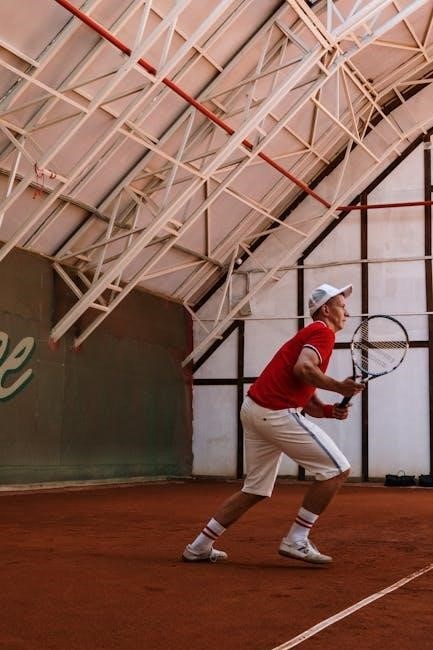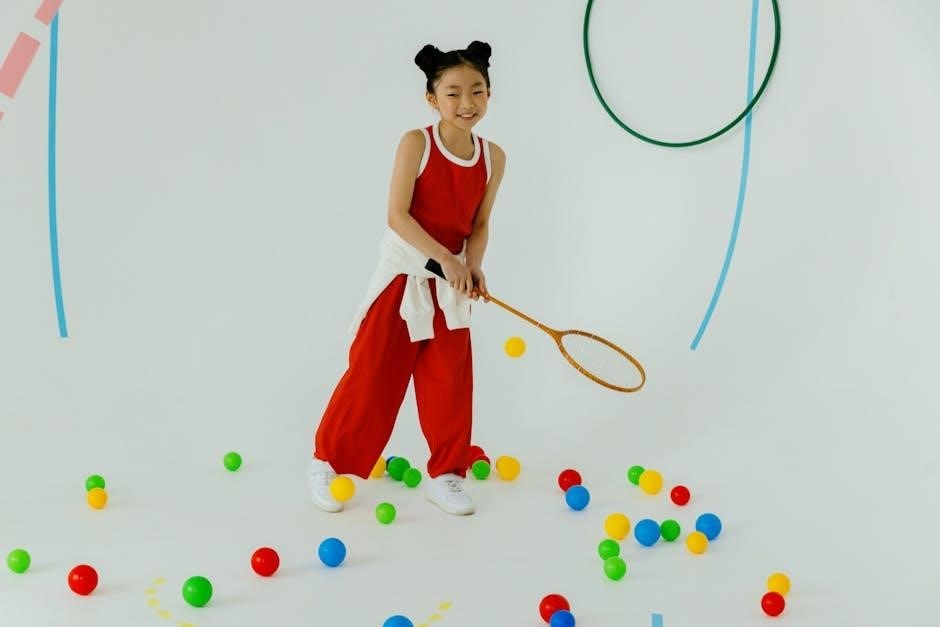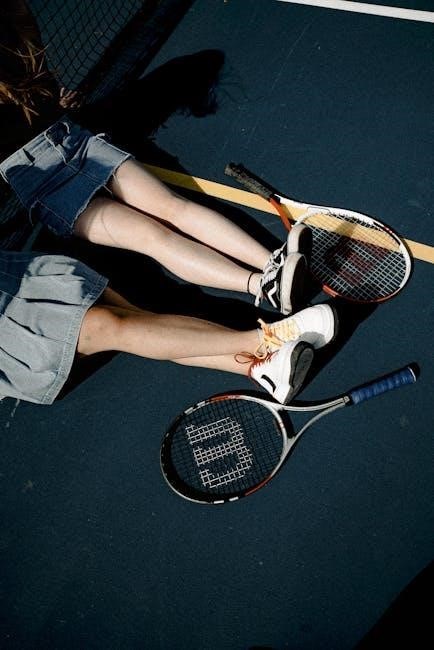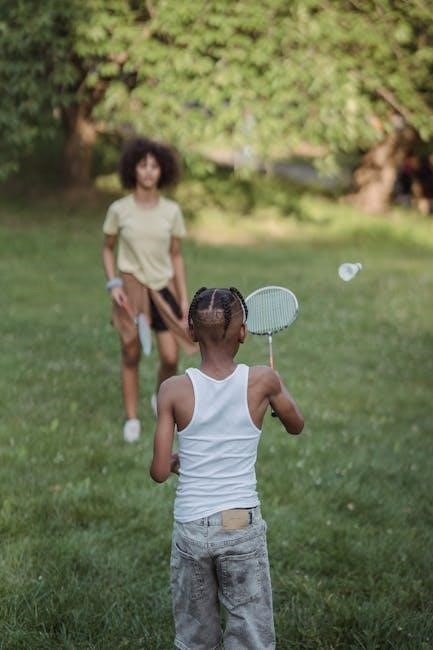Choosing the right junior tennis racquet size is crucial for proper technique‚ comfort‚ and performance. This guide helps parents and coaches select the ideal racquet for young players.
Understanding the Importance of Proper Racquet Size for Junior Players
Proper racquet size is essential for junior players to develop correct technique‚ generate power‚ and maintain control. A racquet that is too long or too short can hinder performance and lead to discomfort or injury. Junior players require racquets tailored to their age‚ height‚ and skill level to ensure optimal swing mechanics and stroke development. Using a correctly sized racquet helps build confidence and improves overall gameplay‚ making it a critical factor in a young player’s progress and enjoyment of the sport.
Overview of Key Factors in Selecting a Junior Tennis Racquet
When selecting a junior tennis racquet‚ key factors include age‚ height‚ and grip size. Racquet length typically ranges from 17 to 26 inches‚ corresponding to the player’s height and age group. Proper sizing ensures optimal performance‚ comfort‚ and technique development. Weight and balance are also important‚ with lighter racquets aiding stroke development. Personal preference plays a role‚ but proper sizing remains critical for young players to maximize their potential and enjoy the game effectively.
Age as a Guiding Factor in Choosing Racquet Size
Age is a key factor in selecting a junior racquet‚ with specific length recommendations for different age groups‚ ensuring proper fit and development for young players.
Recommended Racquet Lengths for Different Age Groups
For children aged 4-5 years‚ a 21-inch racquet is ideal‚ while 6-8 year olds typically use a 23-inch racquet. Older juniors‚ aged 9-10‚ often transition to a 25-inch racquet.
These lengths are designed to match developmental stages‚ ensuring proper swing mechanics and control. The right size helps young players develop technique and enjoy the game more effectively.
How Age Correlates with Racquet Length and Player Height
Age is a key factor in determining racquet length‚ as it often correlates with a child’s height and developmental stage. For example‚ children aged 4-5 years typically use a 21-inch racquet‚ while those aged 6-8 years graduate to a 23-inch racquet. By ages 9-10‚ juniors often transition to a 25-inch racquet. Racquet length aligns with height ranges‚ ensuring the equipment suits the player’s physical growth and ability. Monitoring both age and height helps in selecting the appropriate racquet size for optimal performance and comfort.

Height as a Primary Determinant of Racquet Size
Height is a reliable indicator for selecting racquet size‚ as it directly relates to a player’s reach and control. Racquets are tailored to height ranges‚ ensuring optimal fit and performance for junior players.
Height Ranges and Corresponding Racquet Lengths
For junior players‚ racquet length is closely tied to height. Children up to 100cm tall typically use 19-inch racquets‚ while those between 100-115cm prefer 21-inch racquets. Players measuring 115-135cm benefit from 23-inch racquets‚ and taller juniors (135-150cm) often transition to 25-inch racquets. This correlation ensures proper reach‚ swing‚ and control‚ helping young athletes develop their skills effectively.
Why Height is More Reliable Than Age for Sizing
Height is a more reliable measure than age for sizing junior tennis racquets because it accounts for individual growth rates and physical development. Children of the same age can vary significantly in height‚ and using height ensures the racquet length is appropriate for their reach and swing. For example‚ a child between 100-115cm tall uses a 21-inch racquet‚ while those 135-150cm tall need a 25-inch racquet. This approach helps in selecting a racquet that fits comfortably‚ promoting proper technique and performance.

Grip Size Considerations for Junior Players
Grip size is crucial for comfort and control. Junior players typically use grip sizes 1‚ 2‚ or 3‚ while adults prefer 2‚ 3‚ or 4. Proper sizing prevents discomfort and injury‚ ensuring a secure hold and optimal performance.
Standard Grip Sizes for Children and Adolescents
Junior players typically use grip sizes 1‚ 2‚ or 3‚ while adults prefer 2‚ 3‚ or 4. For children‚ grip size is determined by hand size and comfort. Measuring the space between the fingers and heel of the hand ensures proper fit. A correct grip size prevents injury and enhances control. Most juniors transition from smaller grips as their hands grow. Proper sizing is essential for optimal performance and comfort during play.
Importance of Proper Grip Size for Comfort and Performance
Proper grip size is essential for a junior player’s comfort and performance. A grip that’s too small can cause discomfort‚ while one that’s too large may reduce control. Correct sizing ensures a secure hold‚ allowing for better stroke production and reduced risk of injury. It also enhances precision and power‚ enabling players to perform at their best. Selecting the right grip size is vital for long-term enjoyment and success in tennis.
Junior Racquet Size Chart
A junior racquet size chart correlates age‚ height‚ and racquet length‚ providing a clear guide for selecting the appropriate racquet size based on a player’s developmental stage.
Age‚ Height‚ and Racquet Length Correlations
Age‚ height‚ and racquet length are closely linked in selecting the right junior tennis racquet. For children aged 4-5 years‚ a 21-inch racquet suits heights of 100-115 cm. Ages 6-8 years correspond to 23-inch racquets for heights of 115-135 cm. Older juniors aged 9-10 years typically use 25-inch racquets for heights of 135-150 cm. This correlation ensures proper technique development and comfort‚ adapting to the child’s growth and skill level.
Examples of Racquet Sizes for Specific Age Groups
For children aged 4-5 years‚ a 21-inch racquet is recommended‚ suitable for heights of 100-115 cm. Ages 6-8 years typically use a 23-inch racquet‚ designed for heights of 115-135 cm. Older juniors aged 9-10 years often transition to a 25-inch racquet‚ ideal for heights of 135-150 cm. These examples provide a clear starting point for selecting the appropriate racquet size based on age and height‚ ensuring optimal performance and comfort for young players.
- 4-5 years: 21-inch racquet (100-115 cm height)
- 6-8 years: 23-inch racquet (115-135 cm height)
- 9-10 years: 25-inch racquet (135-150 cm height)
This guidance helps tailor racquet selection to a child’s developmental stage‚ promoting proper technique and enjoyment of the game.
Special Considerations for Younger Players
Younger players aged 4-5 years require smaller racquets‚ typically 21 inches‚ with smaller grips for better control and comfort‚ ensuring proper swing development and technique.
- Age 4-5: 21-inch racquet‚ smaller grip size
- Lightweight frames for easier handling
- Designed for developing basic stroke mechanics
Racquet Sizes for Children Aged 4-5 Years
Children aged 4-5 years typically use junior tennis racquets measuring 21 inches in length. This size is ideal for their height and skill level‚ providing better control and swing mechanics. The racquets are designed with shorter handles and lighter frames to accommodate smaller hands and developing strength. Grip sizes for this age group are smaller‚ usually between 0-1‚ ensuring a comfortable hold. Parents should consider the child’s height‚ with most 4-5 year olds falling into the 101-112 cm range‚ aligning with the 21-inch racquet recommendation.
- Recommended racquet length: 21 inches
- Grip size: 0-1 for smaller hands
- Lightweight frames for easier handling
- Height range: 101-112 cm
Transitioning from Smaller to Larger Racquets
As children grow‚ transitioning to larger racquets is essential for maintaining proper technique and performance. Junior players typically progress from 21-inch racquets (4-6 years) to 23-inch (6-8 years) and eventually 25-inch (8-10 years). This gradual increase aligns with height and strength development‚ ensuring the racquet remains manageable. Parents should monitor their child’s growth and skill level to determine the optimal time for an upgrade‚ avoiding oversized racquets that may hinder control and stroke development.
- Progress from 21-inch to 23-inch as height and strength increase
- Final transition to 25-inch racquets for older juniors
- Monitor growth and skill development for timely adjustments

Advanced Junior Players and Full-Size Racquets
Advanced juniors typically transition to full-size racquets (27 inches) around 12-13 years old‚ offering increased power and control for skilled players ready for adult frames.
When to Transition to a Full-Size Racquet
Transitioning to a full-size racquet typically occurs when a junior player reaches around 12-13 years old‚ with a height of approximately 150cm or taller. This milestone is determined by the player’s strength‚ technique‚ and ability to handle the larger racquet comfortably. Coaches often recommend the switch when the child demonstrates consistent control and power with their current racquet. Moving too early can hinder performance and comfort‚ so it’s essential to assess readiness based on skill level and physical development.
Factors Influencing the Decision to Move to a Larger Racquet
The decision to move to a larger racquet is influenced by several factors‚ primarily the player’s age‚ height‚ and skill level. Typically‚ players transition around 12-13 years old or when they reach about 150cm in height. However‚ physical strength‚ technique mastery‚ and comfort with the current racquet also play significant roles. Coaches often assess whether the player can maintain control and generate power effectively. Personal growth spurts and individual development rates should be considered to ensure the transition is both timely and beneficial for the player’s progress.

How to Choose the Right Racquet for Your Child
Assess your child’s height‚ age‚ and skill level to determine the appropriate racquet size. Ensure proper fit and comfort‚ and consider testing different options before purchasing.
Practical Tips for Fitting and Testing Racquets
When fitting a junior racquet‚ ensure the child can comfortably hold it in their playing hand. Measure hand size to determine the correct grip. Let the child swing the racquet to assess balance and weight. Test the racquet on-court to evaluate maneuverability and control. Encourage the child to play with the racquet for a few minutes to get a feel for it. Consult a coach or fitter for personalized recommendations. Proper fit ensures optimal performance and reduces injury risk.
Role of Personal Preference in Racquet Selection
Personal preference plays a significant role in selecting a junior tennis racquet. While size charts provide guidelines‚ the child’s comfort and feel for the racquet are equally important. Some players may prefer a slightly lighter or heavier racquet‚ depending on their swing style and strength. Allowing the child to test different racquets can help identify their preference‚ ensuring they feel confident and comfortable on the court. This balance between objective sizing and subjective feel is key to optimizing performance and enjoyment. Involving the child in the decision-making process fosters a sense of ownership and enthusiasm for the sport.
Selecting the right junior racquet ensures proper technique and enjoyment. Consider age‚ height‚ and personal preference when choosing. Consult experts and test racquets for the best fit.
Summarizing the Key Points for Selecting the Right Junior Racquet
Choosing the right junior racquet involves considering age‚ height‚ and personal preference. Racquet length ranges from 17 to 25 inches‚ with height being a more reliable guide than age. Proper grip size ensures comfort and performance. Transitioning to larger racquets occurs as the child grows. Testing and fitting are crucial for the best fit. This guide provides a clear framework to help parents and coaches make informed decisions‚ ensuring young players develop proper technique and enjoy the game.
Additional Resources for Further Guidance
For more detailed guidance‚ consult resources like the USTA or ITF websites‚ which offer interactive size guides and expert recommendations. Manufacturer websites‚ such as Wilson or Head‚ provide size charts and fitting tips. Video tutorials on YouTube demonstrate how to measure for the best fit. Local tennis shops often host workshops or offer expert consultations. These resources ensure you make an informed decision tailored to your child’s needs‚ enhancing their tennis experience with the right equipment.
